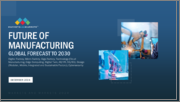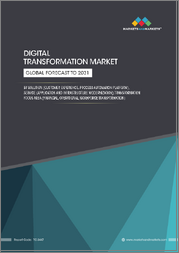
|
시장보고서
상품코드
1623613
제조 시장의 미래 : 디지털 팩토리, 마이크로 팩토리, 기가 팩토리, 기술, 디자인, 사이버 보안 - 지역별 예측(-2030년)Future of Manufacturing Market by Digital Factory, Micro Factory, Giga Factory, Technology, Design, Cybersecurity - Global Forecast to 2030 |
||||||
코봇은 보다 유연하고 효율적인 인간 중심의 생산 환경을 가능하게 함으로써 제조업의 판도를 바꾸고 있습니다.
산업용 로봇과 달리, 코봇은 인간 작업자와 함께 안전하게 작업할 수 있도록 설계되어 반복적이고 육체적으로 힘든 작업에서 작업자를 돕습니다. 이러한 협업을 통해 작업자는 혁신을 주도하는 보다 복잡한 작업에 집중할 수 있어 생산성을 향상시킬 수 있습니다. 코봇은 프로그래밍과 재구성이 편리하고 다품종 소량 생산 산업에 적합하기 때문에 소규모 제조업체가 코봇을 통해 자동화를 시작할 수 있도록 함으로써 자동화 장벽을 낮출 수 있습니다. 코봇에는 우수한 센서가 장착되어 있어 사고 발생 시 움직임을 멈추거나 속도를 늦출 수 있어 안전하며, 보다 조화로운 작업 공간을 구현할 수 있습니다. 인간의 창의성과 로봇의 정밀도가 결합된 코봇을 도입함으로써 제조업은 더욱 민첩해지고, 변화하는 세계 수요에 대응하기 위해 더욱 탄력적이고 반응성이 높은 제조 환경을 형성할 것으로 보입니다.
디지털 트윈 기술은 생산성 향상과 지속 가능한 개발에 초점을 맞춘 제조 시스템 혁신을 통해 제조업 혁신에 중요한 역할을 하고 있습니다. 알테어 엔지니어링(Altair Engineering)이 실시한 최신 세계 디지털 트윈 설문조사에 따르면, 제조업의 71%가 디지털 트윈 기술의 개념을 활용하고 있으며, 디지털 트윈 기술이 비즈니스 혁신에 미치는 영향을 이해하고 있는 것으로 나타났습니다. 기술의 활용은 공급망 효율성을 높이고, 제품 출시 시간을 단축하며, 자원 낭비와 사회적 책임에 대한 위험 없이 품질을 향상시키는 데 있어 널리 보급되고 있습니다. 예를 들어, Boeing은 제품 설계 및 테스트에 디지털 트윈을 적용하고 제품 유지보수에도 적용하여 조립 시간과 유지보수 비용을 절감하고 오류 발생 확률을 개선하고 있으며, BMW는 디지털 트윈 기술을 사용하여 자동차의 성능과 안전성을 통합적으로 재현, 개발 및 최적화하고 있습니다. 통합적으로 재현하고, 개발하고, 최적화하고 있습니다. 미국은 반도체 제조의 디지털 트윈에 자금을 투자하고, 영국은 국가 디지털 트윈 센터를 설립하는 등 정부도 디지털 트윈을 채택하고 있으며, BMW와 Dassault Systemes, LG이노텍, NVIDIA의 조합은 공장 현장의 스마트화 및 디지털 전환을 추진하기 위해 디지털 트윈을 다른 산업에도 적용하고자 합니다.
IoT와 엣지 컴퓨팅은 생산자가 장비의 상태, 사용량 및 잠재적 문제를 지속적으로 추적하고 분석할 수 있게 함으로써 제조업의 상황을 빠르게 변화시키고 있는 혁신적인 솔루션입니다. 이러한 실시간 데이터 수집은 예후 진단 및 예방적 유지보수의 기초가 되어 전체 장비의 가동 중지 시간을 크게 줄이고 기계의 내구성을 연장합니다. 연구에 따르면, 스마트 부품을 솔루션으로 사용하면 장비 고장을 70%, 유지보수 비용을 25% 절감하는 동시에 에너지 효율과 전반적인 제조 효율을 높일 수 있습니다. 예를 들어, 이탈리아 시멘트 회사 Armal S.p.A.는 IoT를 통해 기계의 에너지 지출을 추적하여 에너지 비용을 40% 절감하는 데 성공했습니다. 예를 들어, 허쉬(Hershey)는 제조용 IoT 센서를 통해 14,000갤런 배치당 사탕 크기가 1% 작아질 때마다 50만 달러의 비용을 절감할 수 있었습니다. 이러한 혁신은 전 세계적으로 스마트하고 최적화된 제조 환경을 위한 길을 열어가고 있습니다.
이 보고서는 세계 제조 시장에 대해 조사했으며, 주요 기술 및 동향, 지역별 상황, 2030년 이후의 전망 등을 정리한 보고서입니다.
목차
제1장 주요 요약
제2장 제조업 진화
제3장 제조업 미래를 형성하는 주요 기술과 동향
- 디지털 팩토리
- 제조업 AI
- IoT 및 엣지 컴퓨팅
- 적층 제조
- 디지털 트윈
- 클라우드 제조 및 분산형 제조
- 증강현실(AR)/가상현실(VR)
- 양자 컴퓨팅
- 블록체인
- 접속성(5G 및 6G)
- 마이크로팩토리
- 기가팩토리
- 협동로봇(코봇)
제4장 제조업의 미래 : 특징 정의
제5장 2030년 세계 제조업 상황
- 북미
- 유럽
- 아시아태평양
- 인도
- 기타 지역
제6장 주요 과제와 리스크
- 스마트 팩토리에서의 사이버 보안 위협
- 기술 혁신 대응 과제
제7장 결론 : 2030년 이후의 제조업 비전
LSH 25.01.10Cobots are changing the face of manufacturing as they allow more flexible, efficient, and human-centric production environments. Unlike industrial robots, cobots are designed to safely work alongside human operators, helping with repetitive or physically demanding tasks. This collaboration boosts productivity by allowing workers to focus on more complex tasks that drive innovation. Since programming and reconfiguration are convenient for cobots and perfect for high-mix and low-volume industries, they lower the barriers of automation by letting smaller manufacturers take off on automation with them. They have superior sensors, making it safe to stop or slow movement for accidents, thus making for a more harmonious working space. Manufacturing will be more agile as they implement cobots, a blend of human creativity and robotic precision, to shape a more resilient and responsive manufacturing landscape to meet the changing global demands.
"Digital Twins are Driving the Future of Manufacturing by Enhancing Efficiency and Innovation"
Digital twin technology plays a vital role in the transformation of the manufacturing by innovating its manufacturing systems towards increased productivity and a focused orientation to sustainable development. The latest survey of the manufacturers conducted by Altair Engineering on the Global Digital Twin Survey revealed that 71% of the manufacturers are using the concept of digital twin technology with an understanding of the effect of transforming their operations. The use of technology is prevalent in increasing supply chain efficiency, decreasing the time to introduce products in the market, and enhancing their quality without risking the waste of resources and social responsibility. For instance, Boeing applies digital twins in product design and testing, in addition to its application in product maintenance, to lower assembly time and maintenance costs and improve the probability of errors. BMW uses digital twin technology to replicate, develop, and optimize the instantiation of cars with respect to their integrated performance and safety. They are also being adopted by governments, with the US putting money towards a semiconductor manufacturing digital twin and the United Kingdom creating a national digital twin center. A BMW- Dassault Systemes, LG Innotek, and NVIDIA combination is taking digital twins into other industries to make its industrial application more fatal to smartening factory floors and driving digital transformation.
"Transforming Manufacturing with IoT and Edge Computing Innovations"
IoT and edge computing are innovative solutions that are rapidly changing the landscape of the manufacturing by allowing producers always to track and analyze the status of the equipment and its usage as well as potential problems. Such real-time data collection is the basis of prognostics and preventative maintenance, vastly decreasing overall equipment downtime and lengthening the machines' durability. Based on research, using smart components as a solution can help companies decrease equipment failures by 70% and maintenance expenses by 25% while enhancing energy efficiency and all-around manufacturing effectiveness. For example, the Italian cement company Armal S.p.A., through IoT, managed to cut energy costs by 40 percent by tracking the energy spending of the machinery. For instance, Hershey realized cost savings of USD 0.5 million for every 1% decrease in candy size per 14,000-gallon batch through IoT sensors for production. These innovations are paving the way for smart and optimized manufacturing environments globally.
"North America is revolutionizing its manufacturing sector by embracing advanced technologies"
The manufacturing industry in North America is experiencing a special dynamic shift, predicting continued production dominance through the year 2030. The US, Canada, and Mexico are now focusing on manufacturing with innovative technologies and using sustainable resources to construct factories. Major improvements are noted in using various smart technologies such as artificial intelligence (AI) and digital twins. US Departments of Defense and Energy are funding AI projects that involve research into semiconductor material and improving the application of digital twins in manufacturing. On the other hand, Canada has been funding projects promoting new types of jobs - accelerating the industrial development of the manufacturing sector and promoting a more diverse population in the region's work market. These efforts are critical in building the strength of the region's manufacturing base and its sustainable and innovative future industry.
Research Coverage:
This report examines the future of manufacturing and considers what could happen in terms of advancing automation, smart factory capability, industrial hubs, and more sustainable manufacturing practices. Such an analysis would provide a forward-looking outlook for industry participants navigating the evolving landscape marked by technological innovation and environmental responsibility.
Report Scope
This report insightfully analyzes the transformation trends that will transform manufacturing beyond recognition. Major focus areas are integrating cognitive and immersive technologies, smart and sustainable factories, interconnected manufacturing hubs, innovative approaches toward operational efficiency, revenue diversification, improved production capabilities, and how manufacturing will support the circular economy. Such insights are invaluable for manufacturers, investors, technology providers, and policy-makers seeking to secure competitive advantage while keeping their strategies aligned with future developments in the industry.
TABLE OF CONTENTS
1 EXECUTIVE SUMMARY
2 EVOLUTION OF MANUFACTURING
- 2.1 HISTORICAL CONTEXT: FROM INDUSTRY 1.0 TO 5.0
- 2.2 KEY DRIVERS SHAPING FUTURE OF MANUFACTURING
3 KEY TECHNOLOGIES AND TRENDS SHAPING FUTURE OF MANUFACTURING
- 3.1 DIGITAL FACTORY
- 3.1.1 AI IN MANUFACTURING
- 3.1.2 IOT AND EDGE COMPUTING
- 3.1.3 ADDITIVE MANUFACTURING
- 3.1.4 DIGITAL TWIN
- 3.1.5 CLOUD MANUFACTURING AND DECENTRALIZED MANUFACTURING
- 3.1.6 AR/VR
- 3.1.7 QUANTUM COMPUTING
- 3.1.8 BLOCKCHAIN
- 3.1.9 CONNECTIVITY (5G & 6G)
- 3.2 MICROFACTORIES
- 3.3 GIGAFACTORIES
- 3.4 COLLABORATIVE ROBOTS (COBOTS)
4 FUTURE OF MANUFACTURING: DEFINING CHARACTERISTICS
- 4.1 DATA-DRIVEN DECISION-MAKING
- 4.2 INTEROPERABILITY AND SYSTEM INTEGRATION
- 4.3 CYBERSECURITY AND RESILIENCE IN SMART FACTORIES
- 4.4 FOCUS ON SUSTAINABILITY
5 GLOBAL LANDSCAPE OF MANUFACTURING IN 2030
- 5.1 NORTH AMERICA
- 5.2 EUROPE
- 5.3 ASIA PACIFIC
- 5.3.1 INDIA
- 5.3.1.1 Emerging Markets in India
- 5.3.1.1.1 Semiconductor
- 5.3.1.1.2 Gigafactories
- 5.3.1.1.3 Defense and Aviation
- 5.3.1.1.4 Data Centers
- 5.3.1.1 Emerging Markets in India
- 5.3.1 INDIA
- 5.4 REST OF THE WORLD
6 KEY CHALLENGES AND RISKS
- 6.1 CYBERSECURITY THREATS IN SMART FACTORIES
- 6.2 CHALLENGES OF MANAGING TECHNOLOGICAL DISRUPTIONS



















